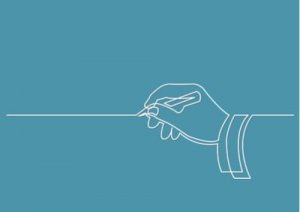Getting to Know Yourself Better Using the Timeline Technique

Psychology uses many different techniques and tools during therapeutic processes. The timeline technique is one of them. It’s used to gain self-knowledge and self-understanding. Although this technique has a humanistic and systemic perspective, all types of psychologists use it because it can give them a lot of information about their patients.
Human beings have a present, a past, and a future that form their individuality. Everything that has happened to us is part of our narrative. Giving a meaning to the events that occur in our lives is vital in order to grow as people, gain confidence in ourselves, and accept ourselves completely.
In this article, we want to teach you how the timeline technique works and when you should use it.
How does the timeline technique work?
The basic foundations of this technique are analysis and reflection. A person won’t get the desired result by only “applying” this technique. Thus, it’s important to bear in mind that it also requires an analytical and reflexive effort. Analyzing our timeline allows us to channel and manage the different associated emotions. This includes the ones we always feel, as well as those that we haven’t consciously dealt with.
“Knowing others is intelligence; knowing yourself is true wisdom. Mastering others is strength; mastering yourself is true power.”
-Lao Tzu-
Once you’ve made your timeline, you must delve deeper into the meaning of each element you drew in it. The timeline technique requires a reflexive analysis that’s usually guided with questions such as “How did I change thanks to that experience?“, “What did I lose and gain at that moment?” or “Did I get over that experience?” This way, we’re able to analyze our experiences in a healthy and adaptive way. Uniting our past with our present in a constructive way helps us understand ourselves better.

The best moments to make use of this technique
The timeline technique can be used in (almost) every moment. However, it’s better to use it at the beginning of a therapeutic process or as a means to end a state of confusion. The timeline technique is always going to be useful when someone wants to get to know themselves more in-depth. Understanding everything we’ve been through allows us to better comprehend why we act and feel the way we do.
On the other hand, it’s not recommended to make use of this technique when the patient has just lived a painful or traumatic experience. According to a study from the University of Arizona, during a period of grief (or reaction to a loss), it’s common for patients to show signs of depression. So if a person is experiencing a period of loss or trauma, their mood will most likely introduce a negative bias in the analysis.
“The two most important days in your life are the day you are born and the day you find out why.”
-Mark Twain-
How to carry out this technique
In order to carry out the timeline technique, you have to consider two important phases: the elaboration of the timeline and the critical-reflexive analysis. First of all, grab a sheet of paper and a pencil, draw a straight line, and begin to point out the following events in chronological order:
Phase 1
Define and point out some very important events such as your birth, the birth of your siblings (or any other important relative), the death of a loved one, your marriage, etc. You can use a blue crayon for this.
Phase 2
Point out significant events or very life-changing moments in your life such as moving to a different house or country, the beginning or end of your studies, a significant trip, etc. You’re the one who’s going to determine what’s important and what isn’t. Use a green crayon for this part.

Phase 3
In this phase, it’s important that you point out certain inflection moments. Said moments work as keys that open up critical situations or phases that must be dealt with appropriately. You can use the color red for this. Make sure you point out the moments that you feel have made you stronger.
Phase 4
Lastly, point out “breaking” situations or events. These are situations that marked a before and after in your life. They’re those you feel changed your life or routine and were also traumatic or difficult to process. For these events, you can use a black or any other dark-colored crayon.
Once you’ve drawn your timeline, spend some time analyzing the impact that each and every one of those events you marked has had on your life. It’s okay to analyze beyond the events that you drew on the line and how they’ve shaped the person you are today. Remember that overcoming personal limits and growing as an individual is only possible when you truly know yourself.
All cited sources were thoroughly reviewed by our team to ensure their quality, reliability, currency, and validity. The bibliography of this article was considered reliable and of academic or scientific accuracy.
Beyebach, M. (2010). 200 tareas en terapia breve. Barcelona: Herder.
This text is provided for informational purposes only and does not replace consultation with a professional. If in doubt, consult your specialist.








